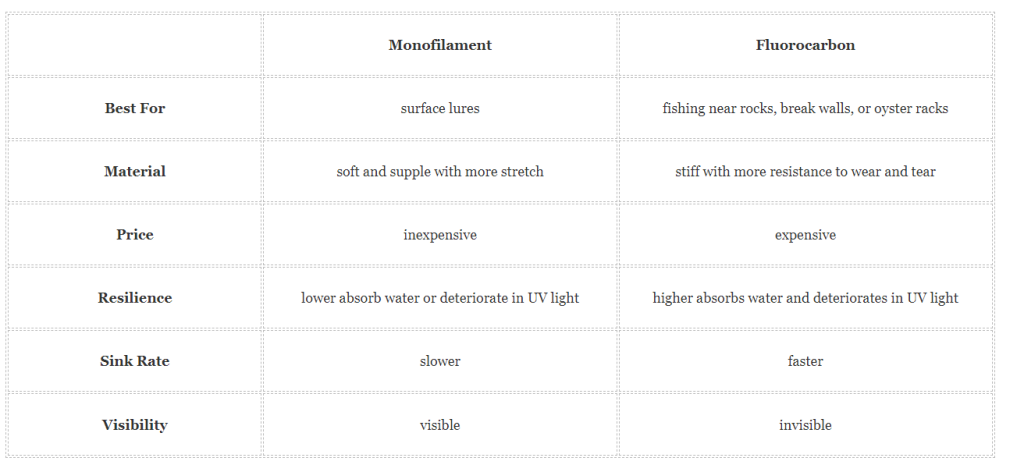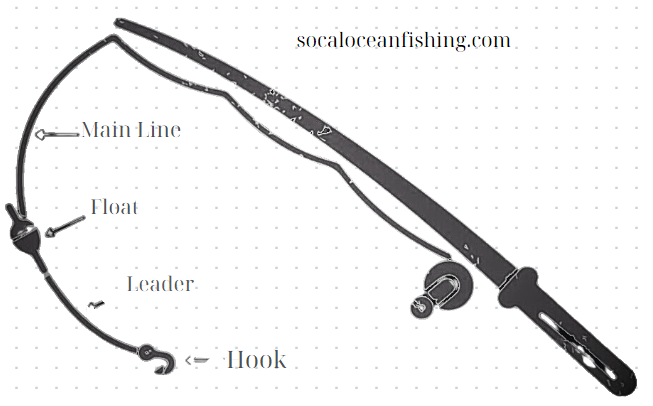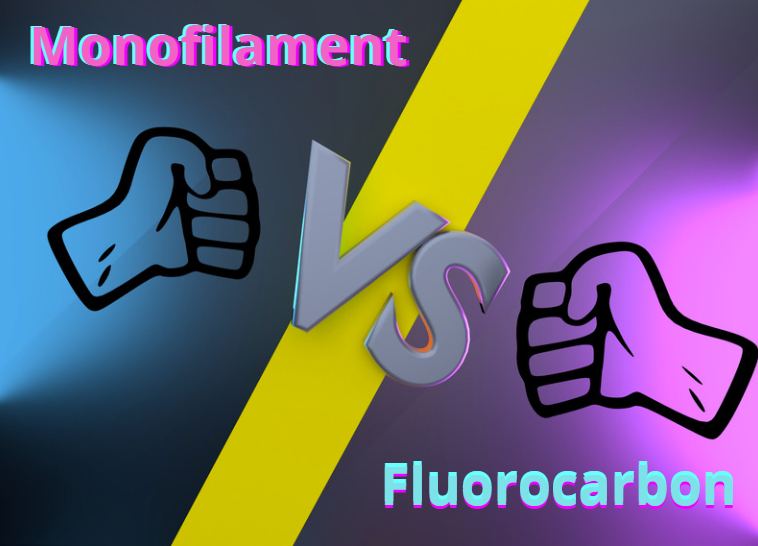Monofilament fishing lines or fluorocarbon fishing lines are often brought to the scale by anglers to compare whether they are suitable for their fishing needs.
And to help you understand better, I will give you an overview of this article and answer what is the difference between monofilament and fluorocarbon fishing line?
Contents
What is the difference between monofilament and fluorocarbon fishing line?
In 1938, DuPont announced the invention of nylon, the first synthetic fiber used in the textile industry today. Monofilament is a single filament made of solid plastic (Nylon, polypropylene, etc.). Many types of monofilament come in all price ranges, but you can buy suitable monofilament for relatively cheap.
DuPont introduced Stren in 1959, a thinner and softer monofilament line that quickly gained favor with anglers despite the initial popularity of the braided Dacron fishing line. Due to their advantages, such as lower visibility, abrasion resistance, and faster sinking, new materials such as Spectra, Dyneema, and polyvinylidene fluoride (PVDF) are also used to manufacture fishing lines. Dyneema is known for its durability and ability to get fish or lures directly, making it ideal for deep-water fishing.
In 1971, fluorocarbon was first invented by the Seaguar company, pointing out that this is one of some modern monofilaments.
At that time, the fluorocarbon fishing line was updated with additional capabilities such as abrasion resistance, shock resistance, and more flexibility than the original version, which was a mono fishing line. To do this, the primary material used in the production of fishing lines is PVDF. PVDF is considered a denser material and does not float nearly as well as nylon monofilament. Because of this, anglers often use fluorocarbon lines when they need lighter baits or lures that sink faster and deeper below the surface without using heavy sinkers.
Monofilament vs Fluorocarbon: Characteristics
Visibility
Mono fishing lines will often have better visibility than fluorocarbon fishing lines due to the thickness of the line. The thicker the fishing lines, the better their visibility will be. Therefore, a mono fishing line is often more suitable for fishing in clear or shallow waters, while a fluorocarbon fishing line is often used to catch wary fish species.
Density
The density of the fishing line will determine whether the fishing line sinks or floats. Typically, fluorocarbon fishing lines will be denser, which helps them sink faster than mono, which has a lower density. Therefore, a fluorocarbon fishing line will be suitable for deep-water fishing, and a mono fishing line will be flawless for shallow-water fishing.
Pound-test
Theoretically, a mono fishing line will have better-breaking strength than a fluorocarbon fishing line, leading to better knot durability.
Elasticity
Monofilament line is more elastic or stretchy than fluorocarbon, making it an excellent choice for shock absorption. Meanwhile, the near-zero stretch of fluorocarbons makes them beneficial when trolling or jerking lures, allowing you to feel the slightest bite.
Resistance of abrasion
The abrasion resistance of fluorocarbon is higher than that of monofilament. That is useful when fishing in areas with rocks, reefs, or other obstacles.

Monofilament vs Fluorocarbon: Characteristics
Monofilament vs Fluorocarbon: Pros & Cons
The Monofilament:
- Pros: durable, thin, and flexible; suitable for various knots; smooth and easy to mold; affordable price; long-time use.
- Cons: lots of memory; low abrasion resistance.
Over the past few decades, monofilament fishing lines have become extremely popular among anglers. This type of wire has certain advantages, such as being durable, thin, and flexible. The mono is suitable for various common fishing knots and is smooth and easy to mold. Additionally, monofilament lines last longer than other types of lines. After all, the monofilament line will be cheaper and longer used than the others on the market.
However, monofilament lines often accumulate memory more quickly than other types of fishing lines, and this is also a big problem with monofilament lines, especially with highly cheap and no-name fishing lines. In addition, the resistance of monofilament lines will be less when soaked in water or exposed to sunlight.
The Fluorocarbon:
- Pros: High abrasion resistance and invisibility in water.
- Cons: Stiffness, high price
In contrast to the mono fishing line, which absorbs water quickly, making it visible in the water, the fluorocarbon fishing line appears invisible. Additionally, fluorocarbon rope is significantly more robust and more resistant to abrasion because of the difference in the chemical properties of fluorocarbon compared to monofilament.
However, the fluorocarbon fishing line is usually much stiffer than the mono fishing line. This will be fine if you use a fluorocarbon fishing line as a leader. In addition, the price of this fishing line will often be higher on the market.
Monofilament vs Fluorocarbon: Using leader
The buoyancy of mono fishing lines is perfect compared to other fishing lines, helping your lure not sink quickly.
Besides, the mono fishing line has more elasticity, but this will depend on what fish you are fishing for. In addition, the fishing line has enough elasticity to create your own knots flexibly. Finally, mono fishing lines will be much cheaper than others, even if you use them as a leader.
However, the mono fishing line will have lower breaking strength than the fluorocarbon line. Besides, memory will quickly accumulate when fishing. Additionally, it is easily damaged by abrasion when used too much in water, limiting the mono’s ability to be a leader. More specifically, if you use a mono fishing line when leading, pay attention to high visibility in the water, as this will give you less chance to the fish.

How to use the fishing line in the right way
Besides the monofilament, use fluorocarbon as a leader if you don’t want your bait to float. The fluorocarbon will help your line sink to the water’s bottom. You can use fluorocarbon unless you want your fishing line to stretch when fishing, and ensure you get a solid hookset in when bass fishing. Finally, you will not see the bite when fishing; fluorocarbon is a choice.
However, fluorocarbon fishing lines are more expensive than mono and braided lines. In addition, the difficulty of tying knots will hinder the fishing line from being used as a leader. Eventually, you need to replace it regularly, especially after each fishing trip, because it loses its durability after being stretched too much.
Related question
Should I use monofilament or fluorocarbon?
In fact, you can use both mono and fluorocarbon fishing lines, and it depends on your needs. However, remember that the fluorocarbon fishing line will be superior to the mono fishing line because of its resistance or invisibility.
For instance, fluorocarbon will be a good choice when the price is not an issue or you want your fishing line to sink deep. Nevertheless, If you want to go surf fishing, you should use the mono fishing line because I like the flexibility of the knots.
What type of fishing line is best all around?
Of course, it’s a fluorocarbon fishing line. The fluorocarbon fishing line was born to devastate the weaknesses of mono fishing lines, such as making them thinner or more resistant and reducing the ability to create memory when fishing. And if you are a professional or are okay with the price, fluorocarbon fishing line will be great.
Conclusion
In general, mono and fluorocarbon fishing lines will have many differences. But to choose which fishing line to use, you must determine your fishing goals and preferences. My article will be helpful to you, and please support me in the following articles.


